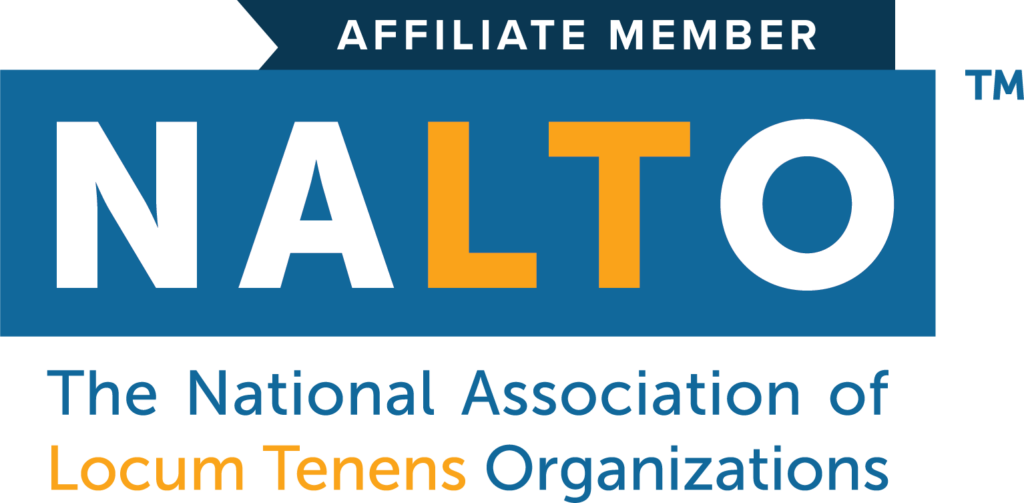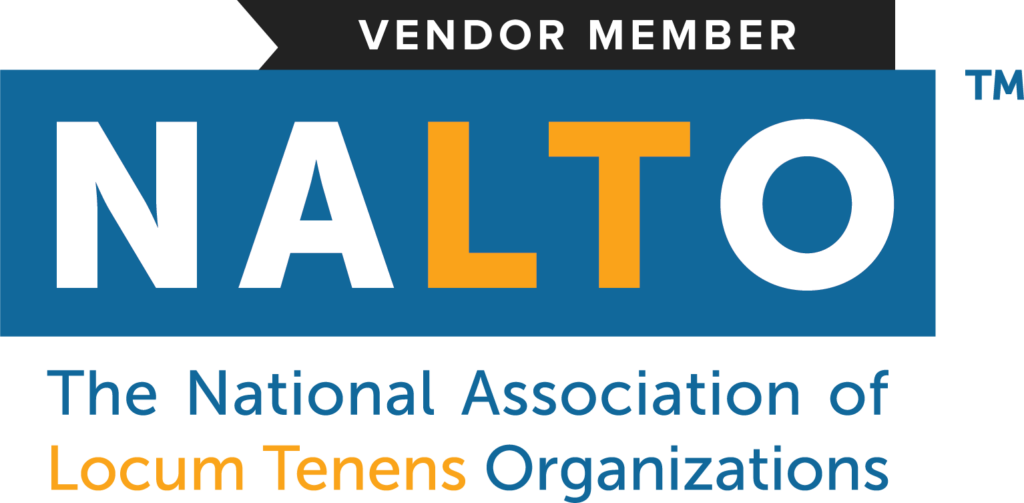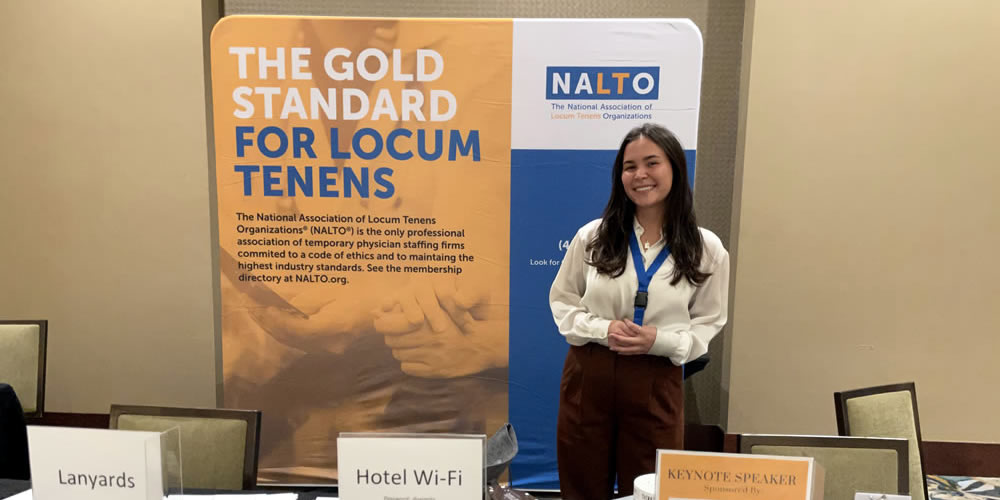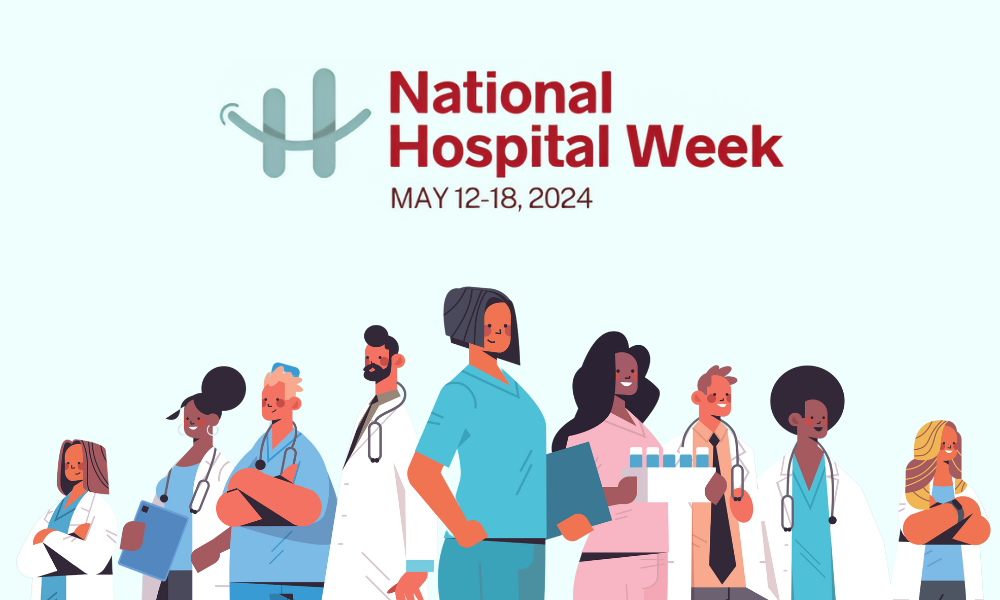NALTO Makes Moves with Unveiling of Logo Suite, Newsletter, Website, and More
(From NALTO, 6/27/23)
The National Association of Locum Tenens Organizations (NALTO) just unveiled its new logo suite for members to display on their website and other marketing materials. The new suite helps distinguish between types of NALTO members: active, affiliate, and vendor. Previously, all organizations used the same general logo to indicate their membership in NALTO.
The new logos were designed by Locumpedia founder Cory Kleinschmidt as part of his contribution to NALTO’s marketing committee, which is chaired by Floyd Lee’s Michelle Bousquet.


One of the most significant benefits of being a member of NALTO is showing providers and facilities that your organization follows best practices in locum tenens recruitment.
Active NALTO members are organizations with a “substantial portion of their business in the locum tenens industry.” These organizations have voting rights on NALTO policy or rule changes, and the NALTO board has determined the organization to they have met the requirements for membership, conformed to NALTO’s standards of ethical practices, and given professional liability insurance to their providers.
Affiliate members are organizations with a portion of business in the locums industry that could be less than 50%. Affiliate members also have the right to vote on general assembly items but not serve on NALTO’s Board of Directors.
NALTO’s vendor members are organizations that provide services for locum tenens organizations. Vendor members — Locumpedia, for instance — still adhere to NALTO ethical practices but don’t have voting power or the right to hold office.
Visit this link to download the active, affiliate, or vendor logo for display on your website, and learn more about becoming a member of NALTO.
NALTO Newsletter and Website Gets A Facelift
Do you subscribe to the weekly NALTO NewsBrief newsletter? It’s one of the best ways to stay on top of what’s happening in the locum tenens industry — aside from reading Locumpedia, of course. The NALTO team recently jazzed up its newsletter format but still highlights top news articles, insights, and events of interest to the locum tenens industry.
Another significant brand update for NALTO is a new website, which was soft-launched in April with an official launch date still to come. , The new website design is the first in many years for NALTO. It sports a modern user experience, brings important member resources front and center, and does a better job of spotlighting NALTO’s two annual conferences. It also makes it easier for organizations to become members of the only locum tenens professional association.
Take Action for NALTO

NALTO has been an advocate for the passage of HR 7881, the NALTO bill, which aims to establish a permanent independent contractor status for locum tenens providers. NALTO members can help spread the message by sending tailored emails via the Take Action Now site page.
2023 Fall Fly-In Approaches
Finally, if you haven’t done so already, register today for NALTO’s 2023 Fall Fly-In conference on Sept. 26-27 in beautiful Park City, Utah, a mountain resort town located on the eastern Wasatch Mountains. Attendees can walk from the hiking trail straight to the keynote presentation led by Teri Gibson.
Gibson, an industry veteran who oversees the marketing strategy, research, media, and email outreach for CHG Healthcare, will present on the “State of Locum Tenens” and showcase insights and trends within the industry. The event is a perfect opportunity for face-to-face networking — Locumpedia will attend again this year. Early-bird registration is now through Tuesday, Aug. 1. See you there!
La Vida Locum
Trends in Emergency Medicine: How the Pandemic Led to Shortages & How Locums Can Help Tackle Demand
(From Medicus Healthcare Solutions, 6/23/23)
The COVID-19 pandemic significantly impacted emergency departments (EDs) around the US, which has led to new trends we’re seeing in Emergency Medicine today.
The pandemic reduced hospital revenue in 2020, as elective procedures were canceled and patient visits declined because people stayed home to avoid contracting COVID in the emergency department. An American Hospital Association (AHA) report said healthcare systems lost an estimated $200 billion in the second quarter of 2020, which forced many departments to cut physicians’ hours during the pandemic to trim costs. This led to trends we’re seeing now in the healthcare industry as a result of these earlier measures taken during the pandemic.
The Emergency Medicine Physician Shortage
The job outlook for emergency medicine physicians from 2021-2031 is “slower than average,” as the Bureau of Labor Statistics expects only a 3% increase over the next 10 years in employment opportunities for these providers. There’s been a decrease in new emergency medicine residents, and the decline in interest among medical students is attributed to concerns about the future job market for emergency medicine because of the impact of COVID.
A Shifting Workforce
Emergency departments have addressed staffing gaps and patient needs by contracting with locum tenens agencies. Emergency medicine locum tenens providers are stepping into roles in EDs to help address the strain on resources and maintain the best possible care.
Why Utilize Emergency Medicine Locum Providers
Locum tenens providers help deliver essential emergency services to all communities. Here are a few benefits of utilizing locum tenens providers in your facility’s emergency department.
- Quality coverage: Emergency medicine locum tenens providers help facilities prevent gaps in care. These providers possess the necessary expertise to handle emergency cases effectively to ensure the best care.
- Safeguarding morale: Bringing in emergency medicine locums during high-demand periods maintains staff morale by reducing workload and relieving stress.
- Offering flexibility: Emergency medicine locums help facilities have the flexibility to address sudden increases in patient volume, unexpected staff absences, or extended leaves. Flexibility helps facilities maximize efficiency without sacrificing care.
- Saving money: Employing locum tenens providers on an hourly or daily basis is a cost-effective alternative to hiring permanent staff.
- Improving access: Leveraging emergency medicine locums enhances access to care by providing services that may otherwise be unavailable. It helps reduce ED overcrowding, resulting in shorter patient wait times.
The job outlook for emergency medicine is cause for concern for the future, and addressing burnout among emergency medicine physicians will be critical. Utilizing locum tenens physicians and advanced practitioners can help alleviate these health system staffing gaps.
Maximizing Staffing Success: 3 Tips for Facilities When Hiring Locum Tenens Providers
(From MPLT Healthcare, 6/27/23)
Locum tenens providers fill many vital staff roles in facilities in the US. MPLT Healthcare developed some tips to help recruiters and hiring managers form a strategy to find the best providers for their organization.
1. Assess your needs
It is important to understand the specific roles and skills an organization requires. If you are looking to make a temporary hire, communicate to a locum tenens staffing team the qualities you need in a provider so they know how to locate the right candidate. The staffing agency can provide tailored coverage solutions if an organization has already assessed its needs.
2. Look For Temp-To-Perm Assignments
If a facility is looking for a permanent provider, hiring locum tenens providers in a temp-to-perm capacity helps evaluate a provider’s abilities before making any long-term commitment. The assignment also allows locum tenens providers to assess whether a facility aligns with their career goals and preferences.
3. Work With An Agency You Trust
Vetting locum tenens providers can be tedious, but partnering with a reputable and trustworthy staffing agency can streamline the hiring process. A professional agency will work closely with an organization’s internal hiring team to establish staffing goals and source providers with the necessary qualifications and credentials.
Demystifying The Physician Credentialing Process: AMA Resources and Guidance
(From Doximity, 6/20/23)
Physician credentialing is vital to the healthcare industry. Credentialing is an ongoing process throughout a physician’s career and consists of three steps: credentialing, privileging, and enrollment.
Credentialing qualifies and verifies a physician’s medical credentials, while privileging grants them authority to work at specific facilities. The enrollment process involves enrolling said physician for insurance payment. The National Practitioner Data Bank gathers and reviews medical data on physicians seeking medical credentials. For physician candidates, training, licenses, malpractice coverage, clinical judgment, and any certifications related to a physician’s specialties are verified.
Some facilities can complete credentialing within a few weeks, while others may take up to six months. The Federation of State Medical Boards provides a state-by-state list of credentialing requirements. Although physician recruiters cannot expedite the process, they can simplify it in four ways.
- By becoming familiar with state requirements.
- Ensuring candidates maintain up-to-date American Medical Association (AMA) profiles, disclosing necessary information.
- Reminding physicians to document procedures they have performed.
- Keeping copies of required documents.
Check out these AMA resources, including a preparation guide and a video, to help demystify the physician credentialing process. Locumpedia also offers tips to help with physician credentialing in our No B.S. Guide to Locum Tenens.
Locum Leaders
SIA Reveals Ranking of 2022’s Largest Locum Tenens Firms; 103 Healthcare Firms Generated $50M+ in Revenue
(From Staffing Industry Analysts, 6/27/23)
Staffing Industry Analysts (SIA) reported recently in its ranking of the largest healthcare staffing firms that 103 agencies generated $50 million or more in US healthcare temporary staffing revenue in 2022. According to the Largest Healthcare Staffing Firms in the United States: 2023 Update, the top firms accounted for 90% of the market, with a total revenue of $61.7 billion.
Aya Healthcare retained its position as the largest firm on the list, followed by AMN Healthcare Services Inc., Medical Solutions, Maxim Healthcare Staffing, and Cross Country Healthcare.
The report also provided segment-specific rankings for various healthcare staffing categories, including travel nurse staffing, per diem nurse staffing, locum tenens staffing, and allied healthcare staffing. Additionally, the report introduced a new category, highlighting the largest international nurse staffing firms operating in the US.
The report’s findings reflect the continued demand for temporary healthcare staffing services, underscoring the importance of these firms in meeting the evolving needs of the healthcare sector. SIA members may access the full report online, which includes detailed data for verticals such as locum tenens, allied health, and more.
CHG’s New Leaders: Leslie Snavley Promoted to President and Bill Heller Takes Reins as New Chief Sales Officer
(From CHG Healthcare, 6/28/23)
CHG Healthcare, the largest physician staffing company in the United States, has promoted Leslie Snavely as the company’s president. The promotion of Snavely, who previously served as CHG’s chief sales officer, went into effect on July 1.
Snavely has held various positions within CHG since joining in 2010, including vice president of marketing and communications, senior vice president of marketing and business development, and chief strategy and digital officer.
She has played a crucial role in developing the company’s strategic plan and overseeing the acquisition of two tech companies. Snavely is also involved in CHG’s Diversity, Equity, and Inclusion efforts.

Heller joined CHG in 2007 and has held several leadership roles within their family of companies, including president of CompHealth Allied, vice president and president of RNnetwork, and president of Weatherby Healthcare.
Heller’s primary focus will be driving the company’s growth and ensuring patients receive quality care.
Jackson Healthcare Ranks No. 4 in The ‘Top 50 Inspiring Workplaces’ in North America
(From Jackson Healthcare, 6/20/23)
Jackson Healthcare took home the No. 4 ranking in the 2023 “Top 50 Inspiring Workplaces” in North America awards. The organization earned recognition for creating outstanding environments and experiences for its workforce. Jackson was one of three companies from Georgia to make the list and is the only Georgia-based company to make the top 25.
The awards program, organized by Inspiring Workplaces Group, acknowledges companies of all sizes and industries that prioritize positive change and employee well-being.
Jackson Healthcare also received a “best-in-class” distinction for excelling in six critical areas: culture and purpose, leadership, well-being, diversity and inclusion, communication, and employee experience.
Shane Jackson, the president of Jackson Healthcare, expressed his gratitude for the acknowledgment and highlighted the collective efforts of their associates in advancing the company’s mission “of improving the delivery of patient care and the lives of everyone we touch.”
Hire Power
Thrive in Any Situation: Butler Street, NALTO Discuss ‘Essential Ingredients’ To Succeed in Challenging Environments
(From Butler Street, 6/27/23)
Working in the healthcare staffing industry can be challenging, but learning to adapt and take on those daily challenges is a skill that recruiters, hiring managers, and everyone else in the industry must develop to be successful.
Butler Street and NALTO have a webinar titled, “Essential Ingredients to Being Successful in a Challenging Environment” scheduled for Aug. 17 at 2 p.m. ET. During the webinar, Senior Consultant Erika Bantz will discuss common challenges people face daily on the job. Bantz will give attendees strategies to help them dig deep and find the ingredients necessary to be successful, regardless of how challenging the environment may be.
These “essential ingredients” for success help attendees understand the value of the customer relationships they build — Bantz will also lay out the specific skills to use each day to rise above the challenge and thrive in any environment.
Register at this link today for the NALTO Education Committee and Butler Street event.
Making the Rounds
Healthcare Leaders Give Insight Into Why Today’s Physicians Are Experiencing Burnout
(From Becker’s Hospital Review, 6/23/23)
Physician frustration and burnout have become significant issues for the healthcare industry over the past few years. An AMA survey found that in the wake of COVID-19, only 57% of doctors would choose medicine again, with 63% of physicians saying they experienced burnout. Becker’s Hospital Review spoke to several healthcare leaders who identified the top issues contributing to physician burnout and dissatisfaction.
Here’s what a few of them had to say:
Thomas Corkery, DO, and chief medical officer at Canonsburg, Pennsylvania. Hospital/Allegheny Health Network says the “administrative burden of practicing medicine has gotten larger between electronic health records and the kind of [pre] authorizations” needed for simple testing, which he believes has contributed to burnout among doctors. Dr. Corkery suggested that the bureaucratic hoops doctors must jump through have also zapped physicians’ energy to practice.
Ryan O’Connell, MD, and regional director of quality at Hartford Healthcare in Fairfield, Connecticut, says, “Many physicians, especially in primary care, are feeling much more strain because patients have more direct access to them around the clock.” Patients were strongly encouraged to sign up for patient portals during the pandemic, creating an illusion of an “email” dialogue with their physicians. Also, federal guidelines “pushed most health systems to provide immediate access to notes and test results — often patients see results before their physicians do, and this invariably leads to questions,” Dr. O’Connell says. While this can create a positive patient experience, it adds to the providers’ workload.
Eric Katz, MD, chief medical officer at Banner Estrella Medical Center in Phoenix, Arizona, says burnout could be related to trust issues because many people are skeptical of anyone outside their immediate circle. “As a result, patients trust their care team less, physicians trust their employers less, and the close relationships between co-workers become threatened,” Dr. Katz says.
Read the full article from Beckers to see what other physicians say contribute to burnout and dissatisfaction they are experiencing in hospitals across the US.
Survey: Cost, Convenience Important Factors in a Patient’s Decision Where to Receive Care
(From xTelligent Healthcare Media, 6/21/23)
A recent Healthcare Patient Consumer Survey conducted by JLL revealed factors beyond cost, such as convenience and location, influence patient access decisions. The survey, which included responses from around 4,000 US healthcare consumers, indicated that clinics centrally located can help increase an organization’s market share. While cost was the primary factor in access decisions, patients prioritized visiting providers that accept their insurance.
Convenience, particularly regarding office location, ranked as the second-most influential factor in choosing a healthcare provider — travel times were a significant consideration. Patients who rated their satisfaction highly mentioned the convenient location, easy parking, and ease of navigation.
The survey highlights the importance of balancing convenience and costs for healthcare organizations. A location strategy can improve your organization’s reach and enhance care outcomes. For example, co-locating clinic offices with other service sectors, such as pharmacies or grocery stores, may also be advantageous, as many patients combine doctor visits with errands.
Patients also responded favorably to retail health clinics, with most patients expressing willingness to access healthcare at such facilities. Retail clinics were top-rated among Millennials and Gen Z patients, and those who need to make appointments quickly, the survey said. as well as those prioritizing quick appointment availability.
Some of the most important factors influencing where patients receive care relate to a physician’s bedside manner and staff attitude, which help create a positive patient experience. While patients often consider online reviews, they primarily look to friends and family for their opinions and experiences of existing providers.
Socially Speaking
From LinkedIn
From Twitter
From Facebook
Second Opinion
From Burnout to Retention: Understanding the Needs of Healthcare Workers
(From HIT Consultant, 6/20/23)
A comprehensive survey conducted by Holon Solutions highlights a significant disconnect between healthcare leaders and workers regarding the primary cause of burnout. While many leaders believe insufficient time with patients is the main stressor, workers identify administrative work as the primary cause of burnout.
Burnout Is Affecting Everyone
Holon’s report indicates 79% of healthcare leaders and 77% of workers have experienced burnout in the past year, with 62% of workers and 52% of leaders considering leaving their current positions or the industry altogether. To address burnout, leaders have implemented strategies such as offering more benefits, increasing wages, and hiring additional staff.
Healthcare’s Top Priority
The survey revealed other concerns of healthcare leaders, including hiring, staffing, retention issues, and keeping up with policies and regulations. Leaders and workers agree that patient notes, summaries, and charting are the top factors preventing them from spending more time with patients.
The Biggest Concerns
Healthcare leaders expressed concern about adopting new technology, particularly regarding the time required for training and the potential for increased complexity. However, these leaders recognize the value of technology in reducing administrative work and duplicative tasks. Around 47% of leaders already use artificial intelligence (AI), and many see the potential of generative AI technologies like ChatGPT in improving care delivery.
There’s an urgent need in the healthcare industry to address burnout, which is no surprise to anyone involved. But leaders can leverage the data from these surveys coming directly from the providers in the field to understand the changes workers desire most.
Unlocking Revenue Potential: Exploring the Benefits of Time-Based Billing
(From LocumTenens.com, 6/23/23)
In 2021, there was a change in evaluation and management service guidelines, allowing for time-based billing. Time-based billing includes billings for work before and after outpatient visits. The difference is beneficial for specialties that require more extended office visits or consultations.
A study published in JAMA compared time-based billing to fee-for-service billing and found that longer patient visits significantly impacted billing. By utilizing time-based billing, medical practices experienced significant increases in revenue over 12 months. If administrators and clinicians can accurately determine the length of patient visits and bill their time accordingly, they can experience revenue growth.
Here are a few tips for deciding between time-based and fee-for-service billing:
Outpatient vs. Inpatient
In the outpatient setting, only face-to-face time with the patient is counted toward overall time, while in-patient providers can bill for face time and time spent documenting or consulting about the patient.
Bill for Counseling
Counseling has a specific definition for time-based billing and includes discussions about test results, treatment recommendations, prognosis, and education. It is critical to understand what time is billable.
Eligibility Required
Time-based billing applies only to physicians and advanced practice providers (APPs), not nurses or medical assistants.
It is essential for any practice considering time-based models vs. fee-based to consult with payors and internal staff for specific code information and seek assistance to build a program around time-based billing that maximizes reimbursement.










